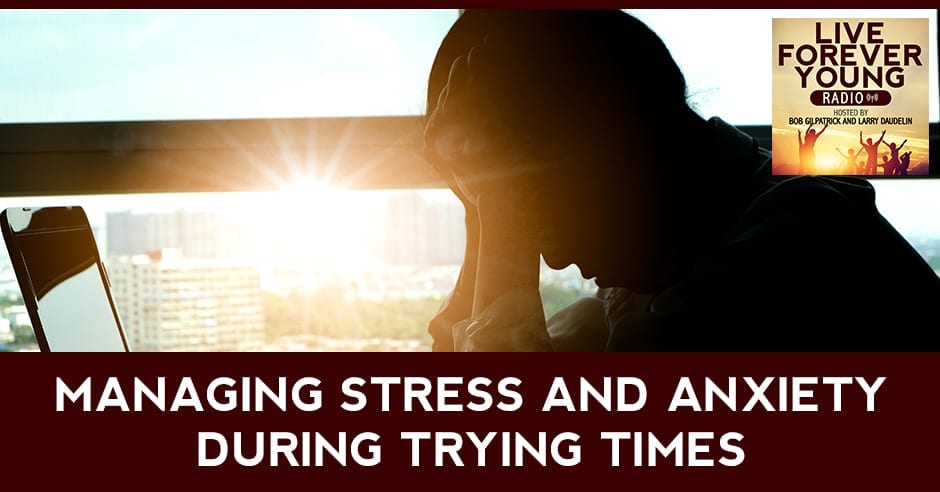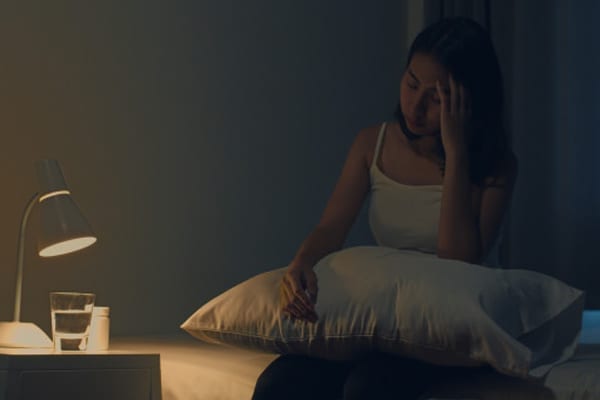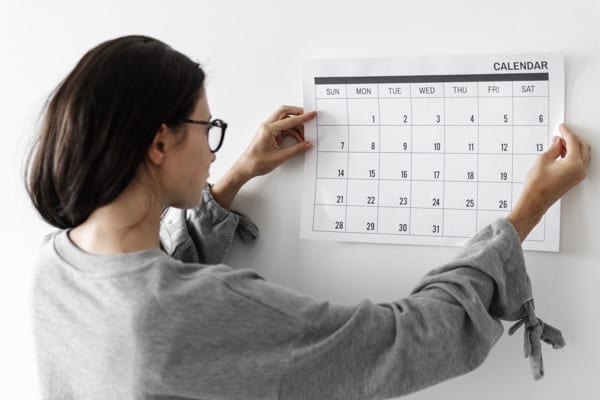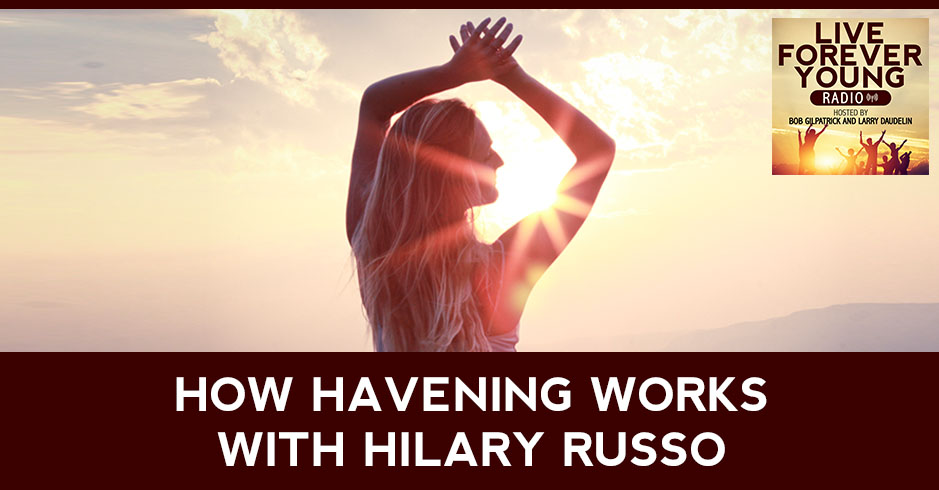Managing Stress And Anxiety During Trying Times

These times can be very confusing because we're dealing with a pandemic that we know nothing about. A study shows that 75% of Americans report experiencing stress just in the past month.
In this episode, Bob Gilpatrick and Larry Daudelin discuss how to manage stress during trying times. Their favorite Studio Dog Zala stops by to say hi and set minds at ease. They answer a question submitted by Christina, one of their listeners.
Bob and Larry share easy to implement tiny habits for you to try on your journey to Live Forever Young. A special Emotional Freedom Technique or tapping technique to reduce anxiety is created and shared with you as well, so get ready to Live Forever Young.
Watch the podcast here
Listen to the podcast here
[fusebox_track_player url="https://feeds.podetize.com/ep/a52eNQ17B/media" title="Managing Stress And Anxiety During Trying Times" social_linkedin="true" social_pinterest="true" social_email="true" ]
Managing Stress And Anxiety During Trying Times
Coping With COVID
We’ll be talking about managing stress and anxiety during the pandemic and our certified holistic nutritionist, Bob Gilpatrick, will answer some questions submitted by our readers. We’ll also be sharing some life-improving tiny habits for you to give a try and a special emotional freedom tapping affirmation from Bob himself. Sit back, relax and get ready to live forever young.
---
Welcome, everyone, to the show. I'm here with Larry Daudelin. Larry and I are the Cofounders of Boomers Forever Young and Live Forever Young Radio. Larry is here with Zala, our beautiful dog. Do you want to introduce her?
Zala is our little therapy dog here at the office. We have quite a few members on our team and Zala seems to go around. The first thing she wants to do is in the morning, greet everybody. She'll sense if somebody possibly isn't feeling well, having stress, maybe a cold or whatever it might be. She'll lay right by that person and make them happy. She's been a real blessing to us. Zala is a standard poodle, cream in color, big almond brown eyes, great temperament and she absolutely loves to come here. She cannot wait to get here and to see everybody. She's extremely special. Everybody here loves her.
We're all pet lovers here. If you happen to have your dog or cat that you would like to send to us, that would be fun. We could have a good time. You’ve got to meet Zala. I know everybody else has their own special dog, cat and maybe a turtle. Send it to us because we would love to see that. It would be great for every one of our episodes. You can see how calm she is. She's sitting here waiting to be told what to do. As soon as we let her out of this studio, she is going to walk around and see who needs her love.
This is our first episode of the show. Because of the time that we're here, which is October of 2020, this is unusual circumstances where people are under a lot more stress than they have been in quite some time, according to the studies, more than even back at 9/11.
Not only is stress but it’s also confusion. The confusion comes from doctors that'll say, “Wear a mask.” The next week, they say, “Don't wear a mask.” Governors that are saying, “Don't go out of your house,” or the governors that are saying, “Go out of your house.” It's got to be very confusing because we're dealing with a pandemic that we know nothing about. We don't know how serious it is. We don't know if it's going to mutate or not mutate. The only thing that we do know is that it seems to be getting better, but will it get worse? I wave on the side of safety. I always wear a mask and be careful where I go. I try to do social distancing. Those are the things that they're telling us to do and we should do them only because they make common sense.
We've got some studies here that have come out regarding COVID, but even before that they see under normal circumstances, 75% of Americans report experiencing stress in the past month. It's resulting in them having trouble sleeping. We know that having trouble sleeping has a detrimental effect on many things, including your affect, whether it's depression or anxiety, but also on your longevity and your overall health. This is a big issue. With the studies related to COVID that we're looking at, even the CDC, they did their own study and found that over 40% of their respondents to the study were reporting anxiety, depression or symptoms of trauma related to the COVID. They're saying that this is the worst numbers they've ever seen even after the depression of 2008 and 9/11. This is a good time to talk about this.
There are better records and more accessible to people than what there was many years ago. The internet gives you immediate access to many things. The media gives you access to not necessarily the correct things. Sometimes they're good. Sometimes they're bad. This is where the confusion is. You listen to ABC, they might tell you something. You listen to NBC, they might tell you something different. You listen to Fox Radio, everything's different. What do you do? I try to calm my mind when I go to sleep. I have been very fortunate with the products that we have. I do get eight hours of sleep and I didn't use to get eight hours of sleep, but I had to get a mindset. It's one of those things. That’s what happens, but it's existing. You have to learn how to live with it and learning how to cope with it is very difficult. You have a natural stress release as to what you need to try to find.
As part of this, we have a question and answer opportunity. I understand we have one question that came in.
It relates a lot to what Larry was talking about. I'm glad you brought it up. What we got here is a question from Christina and what she asked is, “What is something that I can do every day to help manage the stress of having to work from home, teach my child, and deal with the general anxiety that this time has brought into everyone's daily life?” If you could speak about that, what can she do to manage everyday stress? There's more than one thing going on.
Christina, if you're reading this, thank you for your question, because it's a question that 80% of housewives or people who work are struggling with. What did COVID do? Keep your children at home, home study and homeschool. How do you do that? Your position says you can't be at home. What do you do? I don't know what Christina's situation is, but we're going to try to address this for you. We can't get it all in one answer. Bob, if you want to address that a little bit more?
One of the things that are important, especially during COVID, is that people have to have a new routine. The old routine they had before COVID was different and routines are very valuable for people. Routines help people to have stability, but in this case, you also want to be flexible because things are changing quickly and there's new information. Especially during stressful times, it's valuable for people to start their routine first in the morning. What I like to do is use a breath exercise. When you can stop for a minute when you first wake up and breathe in slowly to the count of five, breathe out slowly to the count of five and begin doing that rhythmically. In this case, if people have children, they can do that with their children as well.
I like that idea because we're bringing family unity in and the children are learning at the same time. We're talking about a natural calming remedy that they can do together as a family. That's the whole key. Before this, people were all doing their own thing like kids running someplace else while the mothers are here. Now it's time to bring the family together like they used to be together.
Another thing that as people began doing this rhythmic breath, the next thing that's important is to be able to focus on what you're grateful for. The reason that this is important is that even before COVID, the study showed that the average person in the United States was of the belief that everything is not okay 95% of the time and only 5% of the time did they believe that everything was okay. What happens when you're stuck in that thought pattern is these thoughts are in your prefrontal cortex. You are sending a signal to your heart muscle and your heart muscle beats with varying degrees of variability based on your thoughts. Your heart muscle sends a signal back to your brain to a different part of your brain called the amygdala.
Your amygdala is the seat that helps decide if everything's okay or if you need to be under stress and secrete more stress hormones. The amygdala then sends the signal to the prefrontal cortex and back to the heart. You get stuck in this loop. That's why people are of the belief 95% of the time. It's not that 95% of the time everything's not okay. It's what they believe. By focusing on gratitude, you interrupt this. If you begin to focus on gratitude, for example, Zala was here. She's something to be grateful for. If you do your rhythmic breathing and say, “I'm going to focus on gratitude. I'm very grateful for Zala,” this is a good thing, but if that's all you do, it will be fleeting and it won't be all that much help.
This is where you want to say, “What are the aspects of Zala that I'm grateful for?” “I'm grateful for how soft she is when I pet her. I'm grateful for how intuitive a sympathizer and healer she is. I'm grateful for her beautiful eyes.” As you think about all of the different things, that companionship, how grateful you are to see her first thing in the morning, this makes the attitude of gratitude linger. The longer you can focus on what you're grateful for, the more your heart rate changes into this variability that you're after. You begin to release your death grip on this readiness to believe that things are not okay. This is a very powerful technique for resolving this.

This is something that's been neglected for a long time. I was watching a television show and they were saying, “I want to make sure that our family sits down every Sunday and we do our gratitude.” It would be nice to do it every day, but at least to bring it in. They’re are married, they have to bring the whole families in and they hold hands. Somebody talks about how grateful they are. That's an excellent idea. My wife and I were sitting here and Zala was sitting next to the chair, looking up at us and we said, “We're so fortunate to have such a good dog.” Before we came into work, a yard guy came in at my house and he says, “Do you have a Band-Aid? I cut myself.” What did Zala do? She walked up to him, looked at him, and started licking his hand. He thought, “What a cool thing to do?” At one time, you wouldn't say, “I'm grateful for that.” You should be grateful for that. You should be grateful for a lot of things that go on in your life.
Pets are one of the best things too because they’re something you can rely on. It always gives you something that you can look back to. You're all alone at the house and you've got your cat there rubbing on your leg or coming up and giving you love when you were maybe feeling a little alone.
There are a lot of people that don't have children and they are alone. This loneliness, they need support too. Let's say they live in a condo and they can't have an animal. Their children live in another state. What do they do, Bob?
I've seen this a lot with people and friends of mine as well. The easiest answer is to reach out over the telephone and make that part of your routine. People will reciprocate. They’re like, “I'm going to speak with George for five minutes each morning at around 9:00 because they live alone.” That's the best way to do it.
Communication with neighbors. FaceTime, what a great thing that is.
A lot of people who were older had to be in the nursing homes and they weren't allowed to have visitors. That's very depressing. I remember hearing that on the news. They wanted people to write them as an old-school pen pal.
If we could help anybody doing anything, I want to throw a recommendation out there, if you have a neighbor, a family member, or anybody that you think you can touch and contact them and say, “Hello. How are you doing? Do you need anything?” do that. There's a lot of self-gratification to that. You're also helping them and they’ll never ever forget that. I had a phone call from my granddaughter and she's in the park. I have three of them. The youngest one says, “Grandpa, I'm in the park. I haven't had to go to the park very much because I can't but when I'm here, I was thinking of you and wished you were here.” She wanted me to hear, “I love you. I wish I could be there too.” That's what it's all about. We're human beings and human beings are not designed to be alone.
You were saying your grandkids went to the park. That's not part of their routine. That's why it's important like you were saying with Christina's question. You can see how poignant it is when a little kid calls you and says, “I haven't been able to go to the park a lot not like I normally do.” They're out of their routine.
In regard to the routine, we were saying that people could replace a routine from before with this new routine of their breathing and their gratitude. You'll say, “I'm not in that habit.” This is a time when we can talk about how people can best create a new habit. There are a few good books on creating new habits. One of them is called Tiny Habits and the author is BJ Fogg. He's a renowned behavioral psychologist. He has this technique that he calls ABC. The C will start with as a celebration that you're going to celebrate executing this new habit. The B stands for the new behavior or the new habit. The A, he calls it an anchoring event. It’s something you do all the time.
For me, I use checking my email. Each time I go and check my email, I stop, take some rhythmic breaths, and think about something I'm grateful for and then I’ll check my email. With Christina, what she could do is to make the anchoring event waking up in the morning or some other part of the routine in the morning. If she goes and turns on the coffee maker, or she goes and says hello to a family member, that can be the anchoring event. This is going to trigger the new behavior. You can be, “I'm going to sit in the chair in the living room with one of my children. I am going to begin this new routine of breath and gratitude.”
The anchoring event is a coffee maker or simply getting up. The B, the new behavior, is the breath with gratitude. The C, is the celebration. That's an important part because it’s the way the human mind works. Behavioral psychology is you tend to repeat what gets celebrated. People can do something simple and the easiest way to come up with your celebration, because you don't want it to feel uncomfortable to you, is imagine something simple like, “I wadded up a piece of paper, I tossed it across the room, and it went into the wastebasket.” What would you do if that occurred and you made the shot?
It’s a big celebration for me.
The celebration is like, “Yes, I made it.” It’s something that's natural for you to create this celebration. This ABC technique is very simple, but it's extremely effective if you use this anchoring event, new behavior that you want, and a celebration.
Everything can be turned into gratitude and the celebration. We have a book out that we give with our kids, the Vibrant Living book. We will send Christina a free Vibrant Living book. We have some stress vitamins that we have for anxiety. I want to gift Christina a jar of each one of those. Let’s send Christina a little gift from us to get her started.
I can do that. I'm sure she'll be grateful. I never thought of that. If you guys have questions that you want us to answer, go to LiveForeverYoungRadio.com. All the readers that are out there, we also have a video of this show. Make sure you check out the video, submit the pictures of your pets, give us some questions that we can answer, and we’ll help you out, especially if you have something that you might not necessarily want to talk to a family member about. We'll have a discussion about it. We would like you to go there and put some questions in.
We can't answer medical questions because we're not physicians, but we can help you in many other ways, getting positive results in your life, and help guide you. This is very valuable. These are things you don't get from your doctor.

We've helped thousands of customers with Boomer products and not just the products, but with people calling, asking us and we help them figure out the right thing that they can do for their health.
Speaking of helping people, a lot of what we've done to help people is we've taught them how to do the emotional freedom technique. The emotional freedom technique is something that is very powerful in helping people reframe thoughts and beliefs that they have that is contributing to their stress. We have videos that are made on these techniques. Let's talk a little bit about that and where this technique came from, what it is and how to do it. We can even do an example for Christina that she could use herself with the specific words that we’ll give her.
We will create an affirmation for her.
A large majority of people are going to be reading this and then if they have an opportunity to see the video, you'll be able to see it. Bob and I will try to explain exactly where we're doing the tapping at, why and how.
The emotional freedom technique is also referred to as tapping. The reason is that people are tapping on their fingertips and your karate chop point.
I'm going to try to explain to the people who are reading about what we're doing. I have five fingers. How do you want to start Bob?
Let's take your right hand and use the middle finger of your right hand. Larry is going to use his left hand because he's left-handed and then you're going to tap on the side of your nail on the opposite hand, starting with your thumb. Tap right on the side of the nail and you want to tap hard enough so you can hear it. Tap five times on your thumbnail and then switch to your index finger. Now, you're going to tap onto the side of your index finger and then keep switching fingers approximately five times. It doesn't have to be exact and then tap on your karate chop point.
To those who are reading, you cup your fingers a little bit and you do all your fingers and you hit on the side.
This is a therapeutic technique that harnesses the power of your life force energy also called your chi. This is the energy that gets manipulated when you go for acupuncture. If you go and get needles put into your wrist or your ear, they're treating these acupuncture points and this is where the flow of energy comes. When you tap on the tips of your fingers, you're waking up your energy system then says, “We're going to do some work here and do some reframing for our own benefit.” It now recruits this energy system to help you with reframing your thoughts.
A lot of people have heard the word meridians or they've read different books about it. We're waking up the meridians.
You're waking up the meridians by doing this tapping. You have to identify something that you want to change or that you want to make better. In the case with Christina, she's having generalized anxiety and a general difficulty dealing with COVID. It's causing this anxiety. If she's like most people, it's causing more anxiety than is necessary because it's becoming this perpetual loop. Tapping can create a pattern interrupt and it also can create a reframing so that you can deal with it more easily.
We’re going to get her out of the loop so that way she can start a new pattern.
A new pattern of thought. Sometimes people will want to ask themselves a question so they can see how well this is working. In Christina's case, she would say, “On a scale of 1 to 10, how much anxiety do I have related to my current circumstances?” It's a 5, 6, or 7. If someone's under extreme anxiety, they might say it's a ten. The reason you're going to do this is after tapping, you're going to feel better and a different number is going to come to you. Sometimes it goes all the way down to zero after a couple of minutes of tapping. That's how strong this is.
There's some language that you have to say while you're tapping.
The language is the second part of it. Tapping on your fingertips, it begins to wake up your meridians, and then you're going to use a scientifically formulated structure for a phrase related to your issue. I’ll use Christina as an example. You start to do the tapping on your thumb and then switched to your fingers. After doing this awhile, it becomes a habit. The phrase is going to go something like this, “Even though up until now, I thought that I had to continue to have this anxiety based on my life circumstances. I completely love and accept myself. I'm so grateful now that I realize my anxiety has begun to wane. I'm beginning to feel at complete peace.” When you're finished with a phrase like this, you then want to cross your hands and cross your heart.
Breathe in, sharp breath through your nose. As you let your breath out, put your hands palm up on your knees and drop your chin down. This is where Christina meets Christina, Christina's head and heart meet. Sit quietly for a minute and feel that peaceful feeling. The reason that you want to do this is you're saying while you're tapping, “I'm grateful that I'm feeling that complete peace.” By pushing in on your heart and putting your hands on your heart, you're giving yourself a rush of oxytocin. The neurotransmitter made in your heart muscle and also in your brain. You're giving yourself a little flood of oxytocin, which is your molecule of love and compassion. You have this paired association between how you're feeling peaceful, the words that you said, and that now has become the new you at the moment.

You and I have been doing this for years. Years ago, when I first started doing this, I didn't clear my mind enough. I still let other things come into my mind. I was going through the motions and then you saw me doing it one day in the office and you said, “We need to do this.” I want you to free your mind. I want you to breathe properly, do this, put everything out and feel that gratitude. When I was done, I put my hand over my heart and I drop my head. All of a sudden, I started feeling this emotion come over me because I didn't want anything else to be in my head. I put my hands down and then my hands felt a rush of goodness that was through to it.
Larry, what we'll be able to do is on our future shows, we can do tapping each time and we'll review tiny habits each time based on questions that come in. We understand that there's a lot of anxiety but in general, in the country, Americans tend to have a problem with anxiety. These are highly advanced techniques. Learning tiny habits from a world-renowned behavioral psychologist is great. This stuff works. In addition to being able to learn, to do tapping not only for yourself but for your friends, your family, and for you to become the one that becomes good at this.
You can go to our YouTube channel, Boomers Forever Young. This is where the show is at and it also has different helpful playlists with helpful techniques.
There are a whole magnitude of things that you can do that can help your health and help you stay into a good positive attitude.
Thank you, everybody, for reading. Raleigh, thank you for running everything and participating. Larry, thank you very much.





Leave a comment